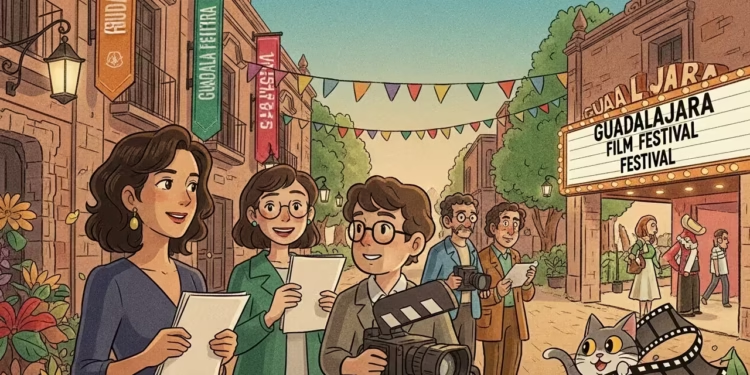BREAKING: The 40th edition of Mexico’s famous Guadalajara International Film Festival came to an end on June 14, 2025. It had record attendance numbers, making it Latin America’s best film festival. Under the direction of festival director Estrella Araiza, FICG had an impressive 29,599 screening admissions and 7,209 masterclass participants, bringing it back to pre-pandemic levels. Honored filmmaker J.A. Bayona said, “It was here that I showed my first short 25 years ago.” This shows how important the festival is to culture.
A Legacy of Great Movies for Four Decades
The Guadalajara International Film Festival has grown from its start in 1986 to become one of Latin America’s most important cultural events. FICG is an important link between Ibero-American cinema and global markets. It is in Mexico’s second-largest city. The University of Guadalajara has always supported the festival, which has given it institutional stability that sets it apart from other regional festivals. This has created an atmosphere of intellectual distinction and cultural prestige.
Portugal was the guest country of honor this year, and the famous actress Maria de Medeiros won the prestigious Mayahuel Award. The festival began with “I Am Frankelda,” Mexico’s first stop-motion animated feature. This movie showed how the country’s animation industry is growing.
Brazilian Movies Get the Most Attention Around the World
Brazil won the Ibero-American competition without a doubt, taking home several prestigious awards that show how the country’s film industry is coming back to life. Gabriel Mascaro’s “The Blue Trail,” which won Berlin’s Special Jury Prize, won the Best Fiction Film award, showing that Brazilian movies are becoming more popular around the world.
Anna Muylaert’s “The Best Mother in the World” won a lot of technical awards, including:
- Best Screenplay
- Best Cinematography
- Best Performance for lead actress Shirley Cruz
This social drama about Brazil’s huge wealth gap is a great example of the festival’s dedication to showing movies that have a big cultural impact. The Match Factory’s worldwide distribution makes sure that these stories get to people all over the world, giving Latin American voices more power on the world stage.
The festival’s growth into genre cinema was a big step forward. The new “Cine de Género” section showed horror, fantasy, and science fiction movies. This addition brought the total number of competitive categories to ten. This shows that the festival can change with the times while still staying true to its cultural mission.
The festival’s dedication to different ways of telling stories was shown again by Spanish filmmaker Eva Libertad’s award for “Deaf” and Albert Serra’s documentary “Afternoons of Solitude.” The opening party, which included live music and traditional Lucha Libre performances, drew 3,500 people. This showed FICG’s unique mix of high culture and popular entertainment.
There were 1,473 accredited guests from the industry at the festival’s many market activities, such as:
- Co-production meetings
- Development workshops
- Networking platforms
This professional infrastructure turns FICG from just a place to watch movies into a full-fledged industry center that moves Latin American cinema forward.
Effect on Culture and Future Direction
The record number of people who came to the festival shows that people are excited about going to the theater again after the pandemic. FICG shows that carefully chosen programming can bring in big crowds to art-house and international movies, with almost 30,000 screenings.
Long-term effects point to stronger cultural ties between Mexico and Brazil, more collaboration between Portuguese and Latin American filmmakers, and more recognition for regional filmmakers around the world.
Because the festival was so successful, Guadalajara is now an important stop for international distributors looking for Latin American content.
Frequently Asked Questions
What makes FICG important for Latin American movies?
- The festival is an important place for regional filmmakers to meet international distributors
- It gives new talent a chance to get their careers off the ground while also honoring established artists
What makes this 40th issue special?
- FICG is still changing and important in today’s film culture, as shown by the introduction of genre cinema categories and record attendance
How does FICG stack up against other festivals around the world?
- It has a unique place between big European festivals and smaller Latin American events because it focuses on Ibero-American cinema, has support from universities, and has a wide range of industry programming
What’s next for the festival?
- The success suggests that it should keep growing, maybe by adding more categories and making it even more of a launchpad for Academy Award campaigns
A Movie Future Built on a Cultural Base
The 40th Guadalajara International Film Festival was a huge success, which shows that real cultural programming appeals to both industry professionals and regular people. Brazil’s many wins show that the country’s film industry is growing up, and Mexico’s animated hit “I Am Frankelda” suggests that exciting things are happening in the country’s own film industry.
Estrella Araiza, the festival director, had a vision for sustainability and growth that worked. It has become a model for festivals all over the world. As FICG looks ahead to the next ten years, the solid base built over the last forty years will allow for more innovation and cultural impact.
The festival’s dedication to showing a wide range of voices while still being able to make money keeps it relevant in a film industry that is becoming more complicated every year. It promises another 40 years of great movies.






